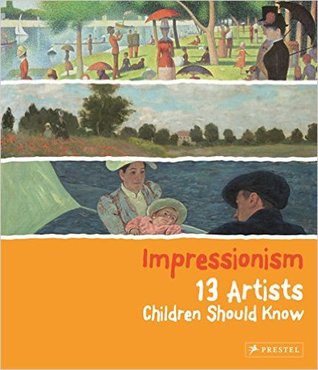Impressionism. Florian Heine. 2015. 48 pages. [Source: Library]
First sentence: Impressionist is the name we give to a special kind of painter. The Impressionists first began painting in France during the late 19th century. They had new ideas about the way we should paint.
Premise/plot: This is a nonfiction book for children and young adults about the Impressionists. (Let's be honest, it's also for adults who are intimidated by the subject and are looking for an easy introduction.) It introduces readers to thirteen artists. These artists are: Edouard Manet, Claude Monet, Auguste Renoir, Gustave Caillebotte, Edgar Degas, Berthe Morisot, Camille Pissarro, Mary Cassatt, Max Liebermann, Georges Seurat, Childe Hassam, Paul Signac, and John Singer Sargent. Of the thirteen artists, many--but not all--were French OR spent a part of their life living in France. (Paris was quite the place to be.) At least two pages--if not more--are dedicated to each artist. Readers will see at least one--if not more--work from each artist. The author does a great job of representing an artist's uniqueness.
Edouard Manet, "Music in the Tuileries Gardens" (1862); "Bunch of Asparagus" (1880), "Asparagus" (1880)
Claude Monet, "Impression Sunrise" (1872); "Wheat Stacks, Snow Effect, Morning" (1891); "Water Lilies and Japanese Bridge" (1899)
Auguste Renoir, "Dance at the Moulin de la Galette" (1876)
Gustave Caillebotte, "Paris Street, Rainy Day" (1877)
Edgar Degas, "Ballet Dancers/The Star" (1876/77); "Dancers Practicing at the Bar" (1877); "At the Races" (1877/78)
Berthe Morisot, "Butterfly Hunt" (1874); "Hanging the Laundry Out to Dry" (1875)
Camille Pissarro, "Boulevard des Italiens" (1897)
Mary Cassatt, "The Letter" (1891); "The Boating Party" (1893/94)
Max Liebermann, "The Parrot Man" (1902); "Terrasse Restaurant Jacob in Nienstedten/Elbe" (1902/03)
Georges Seurat, "A Sunday Afternoon on the Island of La Grande Jatte" (1884-86)
Childe Hassam, "Church at Old Lyme" (1905); "The Avenue in the Rain" (1917); "Rainy Midnight" (1890)
Paul Signac, "Portrait of M. Felix Feneon" (1890); "Grand Canal (Venice)" (1905)
John Singer Sargent, "The Daughters of Edward Darley Boit" (1882)
My thoughts: I liked it. I'm not sure I loved, loved, loved it because I thought it was a bit uneven at times. It included at least one artist that wasn't an impressionist at all. I think when you look at the whole book, one does get a sense of what made them unique and set them apart from what had gone before. I also liked that it is packed with information about each artist. And the representations of the art is nice. Most of the time, the pictures are big and you get an idea of the magnificence of the original piece.
Personally, I don't understand why some artists get three pictures and other artists get only one. For example, I think the author chose the two asparagus pieces of Manet just to squeeze in an interesting "I-didn't-know-that-fact." I don't think from a representative artistic point of view that asparagus is more thrilling than say Renoir's incredibly beautiful work. I think the book should have been 12 Artists Children Should Know and given more space to Renoir.
© 2017 Becky Laney of Becky's Book Reviews


No comments:
Post a Comment